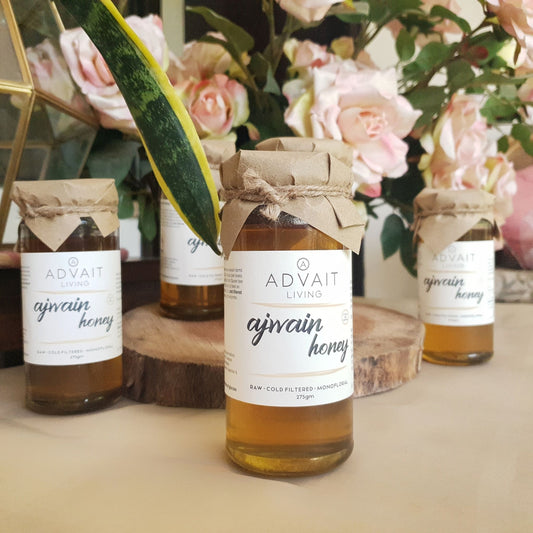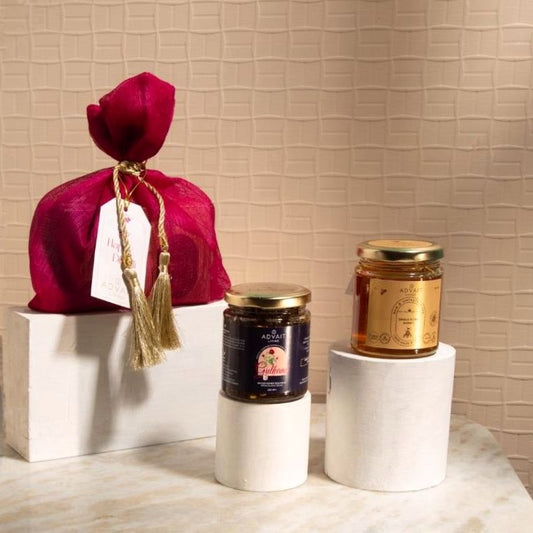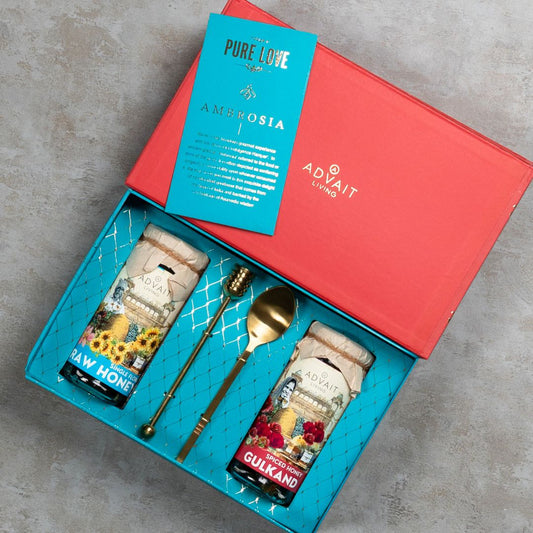Honey, the golden-coloured elixir, enriched with numerous health benefits, is produced by honey bees. It is sweet and is available in two forms, raw honey and processed honey. These two forms highly vary in their physical and chemical characteristics, and also in the nutritional value they hold.
What is Raw Honey?
Raw honey is the concentrated flower nectar extracted from the beehive without performing any alterations that affect its natural characteristics. It is unprocessed and unpasteurised and is as natural as it can get. No sugar or any of its variants is added to this. It comes directly from the bees. And it's the original form of honey that is pure and loaded with high nutritional content.
Every batch of raw honey usually has a distinct taste, flavour profile, texture and consistency (much like a wine) that depends upon the type of flowers that the bees feed on. It also depends on its growing conditions and seasonal variations. That is why each bottle of raw honey looks different, smells different and even tastes different.
Unprocessed raw honey may be labelled as ‘monofloral’ or ‘multifloral’ honey. Monofloral honey means the honey is collected from a single type of flower, and multifloral means honey from a varied set of flowers!
So, honey from a particular flower will be named after it, for example, honey from the nectar of sunflowers will be called sunflower honey and so on! Multifloral honey is usually from the wild or a dense and mixed vegetation area.
What is Processed Honey?

Processed honey, on the other hand, is made from raw honey, but as the term suggests, it is ’processed’. When raw honey undergoes various processes such as pasteurisation at high temperatures, flash heating, multiple filtration, or even treatment with certain chemicals and flavours, it is called “processed” honey.
Processed honey is usually treated in a honey-processing plant where excess moisture and wax are removed, or the honey undergoes pasteurisation at high temperatures. Several processes such as these make the honey much more shelf-stable and uniform in appearance and taste, making it more commercially viable.
However, processed honey loses some of the nutrients, natural enzymes and even natural pollen, which is part of raw honey, rendering it a poorer substitute for real honey!
Your Guide to Differentiating Between Raw Honey vs Processed Honey!
Here is a detailed guide to the various characteristics that render the difference between raw and processed honey:
1. Honey Collection
Pure honey is collected by the bees. It takes 12 bees their entire lifetime to make just one teaspoon of honey!! There is usually only one single ingredient in pure honey: flower nectar. The bees gather the nectar from flowers and take it to their hives.
And then, this honey is collected by us from bee hives that can be found in the wild or from areas where there is an ongoing flowering season. However, ethical beekeeping practices dictate honey collection from beehives made in bee boxes, which are special compartmentalised wooden boxes that ensure no harm comes to the bees when collecting honey.
Ethical raw honey is usually collected from such bee boxes and sold locally. In contrast, processed honey may not necessarily follow the ethical and humane collection of honey. Processed honey also requires a much larger quantity and can typically be honey from any part of the world without much emphasis on collection practices.
2. Geographic Region
Raw honey is sourced from a specific geographic area, field or farm. Due to the specificity behind sourcing, raw honey is usually packed with a label that includes the name of the area and details of the collecting season from where the bees collect nectar. Climate, soil conditions, and the environment of the geographic area also contribute to the rich taste, aroma, and colour of raw honey.
Unlike this, processed honey is just a blend of honey sourced from different parts of the country or maybe even the world and not from a single specific geographic area. Hence, most of the time, any package of processed honey will not contain information about its actual origin or traceability.
3. Processing of Honey
One of the biggest differentiators between the two kinds of honey is the processing of honey.
Ethical raw honey is collected directly from the beehive boxes without harming the bees. Raw honey is raw, unrefined and unprocessed and does not undergo any flash heating, pasteurisation or any other treatment of any kind. Cold-filtration is deployed to filter the honey by using a cheesecloth at best. Once filtered, it is directly packed in bottles to be ready for consumption.
Processed honey, on the other hand, is subjected to various technical extraction processes including preheating, straining, filtration, pasteurisation, cooling and bottling.
Pasteurisation, the main process, involves heating honey above its boiling point, thereby reducing the risk of fermentation and delaying granulation. These processes help increase the shelf-life of honey and many times alter the appearance and taste of honey to make it standard.
Additionally, many honey manufacturing plants may deploy other techniques such as storing honey at low temperatures, ultrasound treatment, filtration and ultrafiltration and may also add certain food additives to increase shelf-life or improve the appearance & texture of the honey.
Even though heavy processing of honey may reduce the risk associated with fermentation and delay the granulation, the chemical composition of honey is highly altered. The changes in the chemical composition lead to a drastic reduction in the flavour and nutritional value offered in the raw honey.
4. Honey Appearance and Taste
Unprocessed honey is unique, as different raw honey varieties exhibit distinctive appearances, textures, smells and floral notes!
The appearance, texture and taste of raw honey depend upon the origin of the honey and are highly influenced by the flowers, temperature (hot or cold), geography (hilly or plains), humidity, and even soil conditions. Even factors like the age of the honey and its crystallisation process determine the appearance and texture of the honey.
Unprocessed raw honey can come in many colours, from deep, dark brown, gold to even white honey. The taste, flavour, texture and consistency also vary depending upon the origin from which honey is actually collected and even the flower nectar profile.
For example, ‘Mustard honey’ is almost white/off-white and has a thick crystallised consistency with a flavour that is rich and sharp. It almost seems like a spread or a jam, instead of a running honey. Pure mustard honey usually tastes sweeter than most honey varieties. On the other hand, ‘sunflower honey’ is light golden/amber in appearance and has a very smooth texture. It may not crystallise and has floral notes with sweeter endings.
On the contrary, processed honey, made at a large scale, appears clear, smooth and uniform in texture for every batch produced. This is due to the processes involved that remove honeycomb debris and bee pollen & changes deployed during the pasteurisation and filtration process.
Some manufacturing plants may also use controlled methods to produce the desired consistency in honey. They use additives such as added glucose powder or sucrose and treat honey at specific and multiple temperatures to produce honey with the desired qualities of texture and consistency.
5. Crystallisation

Crystallisation is the formation of sugar-like crystals in the honey bottle! Don't be alarmed. Crystallisation is perfectly normal and a natural process in raw honey. And it will not cause any change in the nutritional value of the honey. Unlike commercial honey, which doesn't crystallise, raw honey will crystallise. The crystallisation of honey is a guarantee that it is pure and natural.
On the other hand, processed honey undergoes several processes to prevent it from crystallising. This improves the shelf stability of the honey.
Read more about the “Crystallisation of Honey - Natural & Normal”.
6. Bee Pollen Content
Bee pollen is a mixture of the bee’s saliva, nectar, vitamins, minerals and antioxidants and is collected by worker bees. It is enriched with many nutritional components like carbohydrates, proteins, amino acids, lipids, vitamins, minerals, polyphenols, carotenoids, etc.
Bee pollen acts as the best dietary supplement and is widely known for several health benefits. This helps the children dealing with the loss of appetite and malnutrition. It is also evident from research that bee pollen strengthens muscles and possesses antibacterial, antioxidant, anti-inflammatory, anticarcinogenic, and antiallergic properties.
Raw honey will always have trace amounts of bee pollen in it. It is this bee pollen that renders nutritional components and special properties to the raw honey, making it a great source for nutrient supplementation.
Processed honey will usually lack the bee pollen along with its nutritional value, and therefore it is less favourable for dietary benefits.
7. Shelf Life
Honey is non-perishable in nature. However, there is a considerable variation in the shelf life between raw and processed honey. The raw honey does not undergo chemical processing and is directly extracted from the beehive. This eventually lessens the shelf life of raw honey compared to processed honey.
The processed honey is treated with various preservatives to extend its shelf life. These preservatives are not ideal for better health in the long run. Even though the shelf life of raw honey is shorter, it retains high nutritional value, unique taste and flavour without any toxic preservatives.
8. Health Benefits of Honey
Raw honey is packed with high nutritional components such as amino acids, vitamins, minerals, enzymes, carbohydrates and water. The antimicrobial properties of raw honey destroy the cell wall of bacteria and inhibit their metabolic pathways. The presence of volatiles, organic acids, beeswax, nectar, pollen and propolis increases the antimicrobial properties in the raw honey.
A study was conducted to evaluate the efficacy of the topical application of honey in wound healing. It was concluded that the topical application of honey for wound healing is more efficacious than the treatment with silver sulfadiazine, antiseptics, soframycin, acriflavine, etc. It shows how raw honey is ideal for treating wounds.
Raw honey also has a role in the treatment of various eye conditions like conjunctivitis, keratitis, corneal injuries, etc. It also stimulates insulin secretion, reduces blood glucose levels, and improves haemoglobin concentration and lipid profile in the diabetes patient. The cardioprotective effects of raw honey reduce the risk of cardiovascular disease. Raw honey is recommended as an alternative to hormone replacement therapy.
On the contrary, processed honey lacks pollen, beneficial bacteria and enzymes during its extraction process and has fewer medicinal properties than raw honey.
It is also important to note that raw honey does not mean it is sugar-free, organic, pure or ethical. It is always advised to get full details about the raw honey from your bee manufacturers before buying raw honey to make a wise decision.
Conclusion
In conclusion, choosing between raw honey and processed honey always depends on health considerations and individual preferences. Raw honey is without question exceptional, due to its unique flavour, taste, consistency and the presence of a high amount of nutritional content and medicinal properties.
Processed honey, on the other hand, undergoes various extraction processes leading to a reduction in the nutritional content compared to raw honey. Also, processed honey contains some preservatives to increase the shelf life, leaving the consumers to think about the substantial health effects.
While considering the health benefits, sources, processing, appearance, crystallisation, taste, bee pollen content, and shelf life, we highly recommend raw honey over processed honey for its high nutritional value and medicinal properties as a holistic superfood.
Frequently Asked Questions
1. Should I Use Raw or Processed Honey?
Both raw and processed honey differ largely in their extraction processes and health benefits. Raw honey is extracted directly from the beehive and packed as it is, whereas processed honey undergoes pasteurisation and several other processes before it is made available for human consumption. If you are looking for honey with high nutritional value, raw honey is the best choice.
2. Is Processed Honey Safe?
Yes, processed honey is safe to consume, but it has less nutritional value than raw honey. It undergoes processes like pasteurisation and filtration that remove the good microbes and pollen. However, if you are looking for the safest honey with nutritional value, raw honey is recommended.
3. Is It Safe to Eat Raw Honey?
Raw honey contains bee pollen and doesn’t undergo any process to remove microbes. If you are allergic to pollen, it is better to avoid raw honey. Otherwise, raw honey is the best.
4. Does Raw Honey Expire?
No, raw honey doesn’t expire or spoil. But it can get contaminated due to improper storage. If you find visible moulds, odd odours, and weird tastes, it is better to discard them.





























